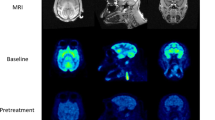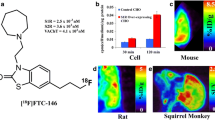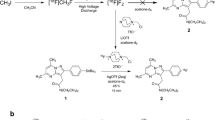Abstract
Purpose
In preclinical studies with rodent models of inflammatory diseases, [11C]CS1P1 has been identified as a promising imaging agent targeting sphingosine-1-phosphate receptor 1 (S1P1) in the central nervous system and other tissues. In preparation for USA Food and Drug Administration (FDA) approval of [11C]CS1P1 for human use, an acute biodistribution study in mice and an acute tolerability and toxicity evaluation in rats were conducted.
Procedures
Acute organ biodistribution and excretion data was obtained using male and female Swiss Webster mice intravenously (IV) injected with 4.8–10 MBq of [11C]CS1P1. The organ residence times for each harvested organ were calculated using the animal biodistribution data, and were entered in the program OLINDA/EXM for C-11 to obtain human radiation dosimetry estimates. Acute tolerability and toxicity studies were conducted in male and female Sprague Dawley rats. Rats were administered an IV bolus of either the vehicle control or 0.3 mg/kg CS1P1. Blood samples were collected and a gross post-mortem examination was conducted at day 2 or day 15 post-injection.
Results
The extrapolated human radiation dose estimates revealed that the highest organ dose was received by the liver with 24.05 μGy/MBq in males and 32.70 μGy/MBq in females. The effective dose (ED) estimates of [11C]CS1P1 were calculated at 3.5 μSv/MBq in males and 5.9 μSv/MBq in females. The acute tolerability and toxicity study identified 0.3 mg/kg as a no observable adverse effect level (NOAEL) dose, which is a ~ 300-fold dose multiple of the human equivalent dose of the mass to be injected for positron emission tomography (PET) imaging studies in humans as a no-observable-effect limit.
Conclusions
The toxicity study in rats suggested that injection dose of radiotracer [11C]CS1P1 with mass amount < 10 μg is safe for performing a human PET study. The dosimetry data supported an injection of 0.74 GBq (20 mCi) dose for human studies would be acceptable.



Similar content being viewed by others
References
Blaho VA, Hla T (2014) An update on the biology of sphingosine 1-phosphate receptors. J Lipid Res 55:1596–1608
Kunkel GT, Maceyka M, Milstien S, Spiegel S (2013) Targeting the sphingosine-1-phosphate axis in cancer, inflammation and beyond. Nat Rev Drug Discov 12:688–702
Soliven B, Miron V, Chun J (2011) The neurobiology of sphingosine 1-phosphate signaling and sphingosine 1-phosphate receptor modulators. Neurology 76:S9–S14
Nishimura H, Akiyama T, Irei I, Hamazaki S, Sadahira Y (2010) Cellular localization of sphingosine-1-phosphate receptor 1 expression in the human central nervous system. J Histochem Cytochem 58:847–856
Dev KK, Mullershausen F, Mattes H, Kuhn RR, Bilbe G, Hoyer D, Mir A (2008) Brain sphingosine-1-phosphate receptors: implication for FTY720 in the treatment of multiple sclerosis. Pharmacol Ther 117:77–93
Brinkmann V, Billich A, Baumruker T, Heining P, Schmouder R, Francis G, Aradhye S, Burtin P (2010) Fingolimod (FTY720): discovery and development of an oral drug to treat multiple sclerosis. Nat Rev Drug Discov 9:883–897
Chun J, Hartung HP (2010) Mechanism of action of oral fingolimod (FTY720) in multiple sclerosis. Clin Neuropharmacol 33:91–101
Garris CS, Wu L, Acharya S, Arac A, Blaho VA, Huang Y, Moon BS, Axtell RC, Ho PP, Steinberg GK, Lewis DB, Sobel RA, Han DK, Steinman L, Snyder MP, Hla T, Han MH (2013) Defective sphingosine 1-phosphate receptor 1 (S1P1) phosphorylation exacerbates TH17-mediated autoimmune neuroinflammation. Nat Immunol 14:1166–1172
Watson C, Long JS, Orange C, Tannahill CL, Mallon E, McGlynn LM, Pyne S, Pyne NJ, Edwards J (2010) High expression of sphingosine 1-phosphate receptors, S1P1 and S1P3, sphingosine kinase 1, and extracellular signal-regulated kinase-1/2 is associated with development of tamoxifen resistance in estrogen receptor-positive breast cancer patients. Am J Pathol 177:2205–2215
LaMontagne K, Littlewood-Evans A, Schnell C, O'Reilly T, Wyder L, Sanchez T, Probst B, Butler J, Wood A, Liau G, Billy E, Theuer A, Hla T, Wood J (2006) Antagonism of sphingosine-1-phosphate receptors by FTY720 inhibits angiogenesis and tumor vascularization. Cancer Res 66:221–231
Sukocheva O, Wadham C, Gamble J, Xia P (2015) Sphingosine-1-phosphate receptor 1 transmits estrogens' effects in endothelial cells. Steroids 104:237–245
Jin H, Yang H, Liu H, Zhang Y, Zhang X, Rosenberg AJ, Liu Y, Lapi SE, Tu Z (2017) A promising carbon-11-labeled sphingosine-1-phosphate receptor 1-specific PET tracer for imaging vascular injury. J Nucl Cardiol 24:558–570
Liu H, Jin H, Yue X et al (2017) PET study of sphingosine-1-phosphate receptor 1 expression in response to vascular inflammation in a rat model of carotid injury. Mol Imaging 16:1536012116689770
Liu H, Jin H, Yue X, Luo Z, Liu C, Rosenberg AJ, Tu Z (2016) PET imaging study of S1PR1 expression in a rat model of multiple sclerosis. Mol Imaging Biol 18:724–732
Liu H, Jin H, Han J, Yue X, Yang H, Zayed MA, Gropler RJ, Tu Z (2018) Upregulated sphingosine 1-phosphate receptor 1 expression in human and murine atherosclerotic plaques. Mol Imaging Biol 20:448–456
Toohey RE, Stabin MG, Watson EE (2000) The AAPM/RSNA physics tutorial for residents: internal radiation dosimetry: principles and applications. Radiographics 20:533–546 quiz 531-532
Vakili A, Jalilian AR, Moghadam AK, Ghazi-Zahedi M, Salimi B (2012) Evaluation and comparison of human absorbed dose of 90Y-DOTA-Cetuximab in various age groups based on distribution data in rats. J Med Phys 37:226–234
Constantinescu CC, Sevrioukov E, Garcia A, Pan ML, Mukherjee J (2013) Evaluation of [18F]Mefway biodistribution and dosimetry based on whole-body PET imaging of mice. Mol Imaging Biol 15:222–229
Zhou X, Elsinga PH, Khanapur S, Dierckx RA, de Vries EF, de Jong JR (2017) Radiation dosimetry of a novel adenosine A2A receptor Radioligand [11C]Preladenant based on PET/CT imaging and ex vivo biodistribution in rats. Mol Imaging Biol 19:289–297
Radiological Protection in Biomedical Research (1991) A report of Committee 3 adopted by the International Commission on Radiological Protection. Ann ICRP 22:1–28 v-xxiv
Acknowledgments
We thank Nicole Fettig, Margaret Morris, Amanda Klaas, and Lori Strong for their assistance with the mouse dosimetry studies. We also thank the Cyclotron facility of Washington University for providing [11C]CO2.
Funding
This work was supported by National Institutes of Health (NINDS NS075527, NS103988, and NIBIB EB025815) and by a MIR Pilot grant #19-014 from Mallinckrodt Institute of Radiology, Washington University School of Medicine, Missouri.
Author information
Authors and Affiliations
Corresponding author
Ethics declarations
Conflict of Interest
The authors declare that they have no conflict of interest.
Additional information
Publisher’s Note
Springer Nature remains neutral with regard to jurisdictional claims in published maps and institutional affiliations.
Electronic supplementary material
ESM 1
(PDF 108 kb)
Rights and permissions
About this article
Cite this article
Liu, H., Laforest, R., Gu, J. et al. Acute Rodent Tolerability, Toxicity, and Radiation Dosimetry Estimates of the S1P1-Specific Radioligand [11C]CS1P1. Mol Imaging Biol 22, 285–292 (2020). https://doi.org/10.1007/s11307-019-01380-z
Published:
Issue Date:
DOI: https://doi.org/10.1007/s11307-019-01380-z




